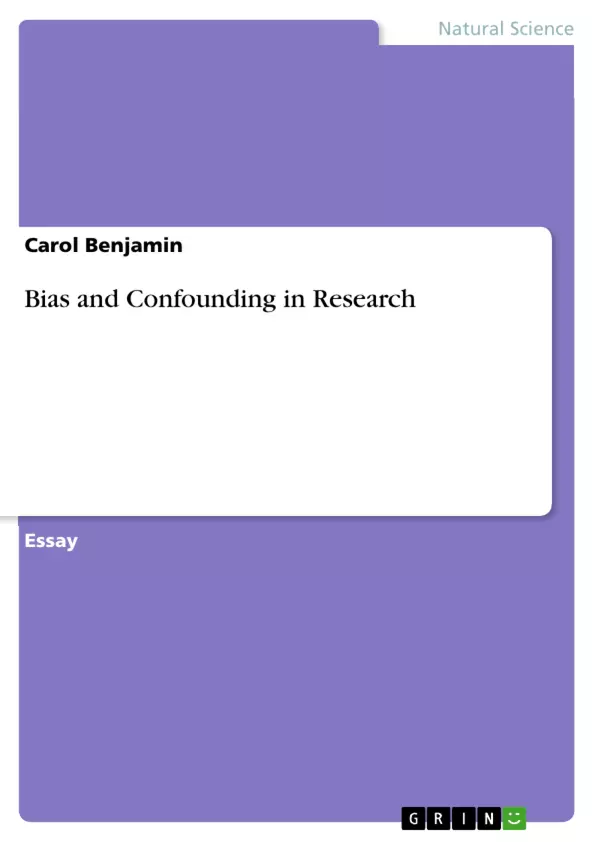This assignment involves identifying limitations of the proposed study. The potential bias and limitation of the study is described. These involve proposed Study Design, proposed Sampling Method, proposed Data Sources/Data Collection Methods, proposed Analytic Methods. Finally the potential confounding factors in the study is discussed.
Inhaltsverzeichnis (Table of Contents)
- Confounding
- Limitations of proposed Study Design
- Limitations of proposed Sampling Method
- Limitations of proposed Data Sources/Data Collection Methods
- Limitations of Proposed Analytic Methods
- Potential confounding factors
Zielsetzung und Themenschwerpunkte (Objectives and Key Themes)
The objective of this study is to identify limitations and potential biases within a proposed case-control study design investigating predictors of severe H1N1 infection. The study explores potential biases and limitations across various aspects of the research process, including study design, sampling methods, data collection, and analytic techniques. It also addresses the potential influence of confounding factors.
- Study Design Limitations and Bias
- Sampling Method Limitations and Bias
- Data Collection Method Limitations and Bias
- Analytic Method Limitations and Bias
- Confounding Factors in H1N1 Infection Research
Zusammenfassung der Kapitel (Chapter Summaries)
Confounding: This chapter analyzes the limitations and potential biases inherent in a proposed case-control study designed to investigate predictors of severe H1N1 infection. It examines potential issues related to study design, sampling methods, data sources, data collection methods, and analytical techniques. The chapter highlights the susceptibility of retrospective case-control studies to selection bias and the challenges of ensuring representativeness in both case and control groups. It also discusses the impact of small sample sizes on the interpretation of results and the limitations of specific statistical tests such as the Mann-Whitney U test and chi-square test, emphasizing their sensitivity to sample size and data binning. The chapter concludes by exploring the potential confounding effects of seasonal influenza, given the overlapping symptoms between seasonal flu and H1N1, making it difficult to isolate the specific causes of severe H1N1 infection.
Schlüsselwörter (Keywords)
H1N1, case-control study, selection bias, misclassification bias, sample size, statistical significance, Mann-Whitney U test, chi-square test, confounding, seasonal influenza, epidemiologic studies, retrospective studies.
Frequently Asked Questions: Limitations and Biases in H1N1 Case-Control Study Design
What is the main objective of this study?
The study aims to identify limitations and potential biases in a proposed case-control study design investigating predictors of severe H1N1 infection. It examines potential biases across the research process, including study design, sampling, data collection, and analysis, and addresses potential confounding factors.
What are the key themes explored in this study?
The key themes include limitations and biases in study design, sampling methods, data collection methods, analytical methods, and the influence of confounding factors, specifically focusing on how these affect the investigation of H1N1 infection.
What are the limitations of the proposed study design discussed?
The study highlights the susceptibility of retrospective case-control studies to selection bias and the challenges in ensuring representativeness in both case and control groups. The impact of small sample sizes on the interpretation of results is also a key concern.
What are the limitations of the proposed sampling method discussed?
The document points out the challenges of ensuring a representative sample in both case and control groups within a case-control study design, a crucial aspect for minimizing selection bias.
What are the limitations of the proposed data sources/data collection methods discussed?
The document does not explicitly detail specific data sources but highlights the general challenges of data collection in retrospective studies, emphasizing the potential for bias introduction during this phase.
What are the limitations of the proposed analytic methods discussed?
The study discusses the limitations of specific statistical tests like the Mann-Whitney U test and chi-square test, particularly their sensitivity to sample size and data binning. The interpretation of results from these tests in the context of small sample sizes is highlighted as a potential limitation.
What potential confounding factors are discussed?
The potential confounding effect of seasonal influenza is a major concern, due to the overlapping symptoms between seasonal flu and H1N1, making it difficult to isolate the causes of severe H1N1 infection.
What are the key chapters covered in the document?
The document covers Confounding, which is a detailed analysis of the limitations and potential biases in a proposed case-control study of H1N1 infection predictors. It also implicitly covers limitations related to study design, sampling methods, data sources, data collection, and analytical techniques through its exploration of the biases and challenges associated with each aspect.
What are the key words associated with this study?
Key words include H1N1, case-control study, selection bias, misclassification bias, sample size, statistical significance, Mann-Whitney U test, chi-square test, confounding, seasonal influenza, epidemiologic studies, and retrospective studies.
- Citation du texte
- Carol Benjamin (Auteur), 2010, Bias and Confounding in Research, Munich, GRIN Verlag, https://www.grin.com/document/265473



